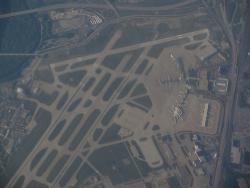
Constructed on 1,040 acres just 10 miles southwest of the city center, the Cleveland Hopkins Airport was the first major airport in the world to provide an integrated system of paved landing surfaces, lighted runways, and a terminal complex consisting of hangars and operating facilities. Overseen by city manager William Hopkins and Major "Jack" Berry - an engineer on loan from the U.S. postal service who eventually became the city's first Airport Commissioner - the project at first was called "Major Berry's Folly" by local residents because of its outlying location.
Throughout the 19th and early 20th centuries, Cleveland had maintained a central position in the shipping of freight, linking Great Lakes industry with the inland river system. The city's early participation in the dawning of commercial flight was intended to bolster its role as a major link in freight and passenger transportation. The airport's formal dedication on July 1, 1925 featured the night arrival of the first transcontinental flight in the history of airmail service.
Facts
- Cleveland-Hopkins' first landing field was 3,600 feet by 4,200 feet and covered in sod, the conventional runway material for light aircraft of the 1920s. A 48-inch drainage line was placed beneath the landing field and connected to more than 13,000 feet of 12-inch lateral piping. Sixty thousand feet of French drains, spaced on 20-foot centers, were subsequently tied into the lateral piping
- The airport's control tower -- built in 1929 to manage air traffic and to advise pilots of wind, air traffic and field conditions -- was the first of its kind in the world. The original radio equipment from the control tower and parts of the airport's original floodlight are on display in the National Air and Space Museum.
- In 1929, the airport served as the first home for the National Air Races, which continued there until 1949. Run in concert with ongoing commercial traffic, the races set several records, including an air-speed record of 252 mph in 1932 by celebrity pilot Jimmy Doolittle.
- During World War II, Cleveland-Hopkins International became the site of the first engine-propulsion laboratory in the United States and the largest such laboratory in the world.



- Major John Berry, An Air Terminal Extraordinary, 1930